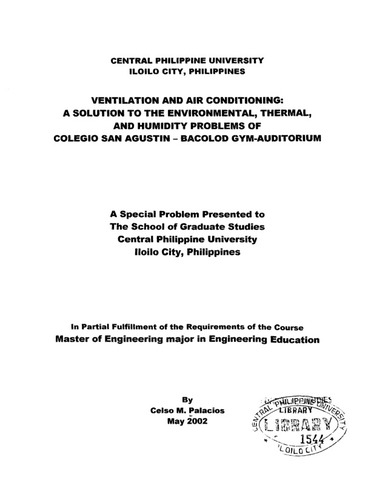Ventilation and air conditioning: A solution to the environmental, thermal, and humidity problems of Colegio San Agustin - Bacolod gym auditorium

Page views
2,238Petsa
2002May-akda
Tagapayo ng Tesis
Tagapangulo ng Panel ng Depensa
Magbahagi
Metadata
Ipakita ang buong tala ng item
Abstract
Introduction
Comfort or industrial air conditioning may have begun when fire was used by man to warm himself. Subsequent development of environmental control included open fire places, furnaces, stoves and the like. The first air conditioning system was designed by Wilis H. Carrier in New York, where it was used to improve the printing quality in a publishing company through thermal and humidity control. Then came the development of self-contained units, where the refrigeration and air conditioning components are put in one factory-enclosed package. A larger split type (the evaporator is separated from the compressor and condenser) units are now used in stores and restaurants. Eventually, new markets for air conditioning of residences opened and are now progressive. Large hotels with the big function rooms, auditoriums, theaters, gym, condominiums, department stores, and other buildings with large space use the centralized air conditioning system.
In educational institutions, physical facilities upgrading help achieve excellence in instructions. Laboratories and libraries are being air conditioned to make them more conducive to research and learning. Malfunctions of electronic equipment have decreased and feedbacks on laboratory learning processes have become more satisfactory.
However, a new problem arose when students, parents, and teachers clamored a better condition during major activities such as graduation rites, institutional religious celebration, and other activities inside the gymnasium, where more than 4,000 people could attend.
Heat exhaustion is the common ill effect on grade school pupils and even female college students with low resistance to rapid thermal changes. This usually occurs during summer, or when outside atmospheric temperature is high. There are times when graduating students attending graduation ceremonies would leave the venue due to heat exhaustion. Administrators cannot force those students to stay because there were already incidents of fainting, vomiting, irritability, and other abnormal physical discomfort during similar activities as mentioned above.
Now, if the air conditioning systems are in place, return on investment can be obtained from rentals during major concerts, sports, and other fund raising activities. These activities are usually scheduled on weekends so that they will not conflict with the academic activities of the school.
Statement of the Problem
This study aims to explore the feasibility of installing a centralized air conditioning system for the Colegio San Agustin- Bacolod Gym-Auditorium.
The study seeks to accomplish the following problem objectives:
[1] The air conditioning to be installed shall produce the desired ideal comfort conditions as designed.
[1.a] Data and estimates measured represents typical values. The technical information used in the calculations shall give valid outcomes.
[1.b] Items that could not be estimated or are not accessible realistically have assumed values that shall yield ideal and optimal results.
[2] The study when applied shall function as expected. The system will perform as prescribed for the school’s clientele and the Negros Occidental community as a whole.
[3] The technical facts resulting from the study can be used as basis by other educational institutions in search for better physical facilities for sports, cultural, and academic activities.
Paglalarawan
Introduction and statement of the problem
Mungkahing Sipi
Palacios, C. M. (2002). Ventilation and air conditioning: A solution to the environmental, thermal, and humidity problems of Colegio San Agustin - Bacolod gym auditorium (Unpublished Master’s special paper). Central Philippine University, Jaro, Iloilo City.
Uri
Special paperMga Paksa
Mga keyword
Kagawaran
School of Graduate StudiesDegree
Master of Engineering major in Engineering EducationLokasyon ng Istante
GSL Theses 620.0072 P171
Pisikal na paglalarawan
59 leaves


